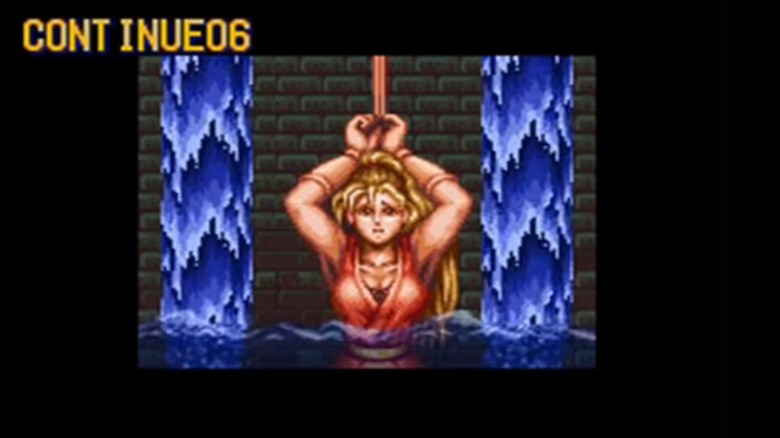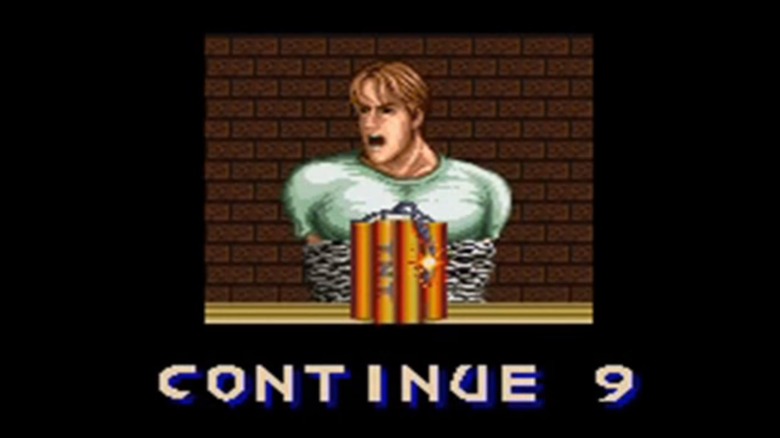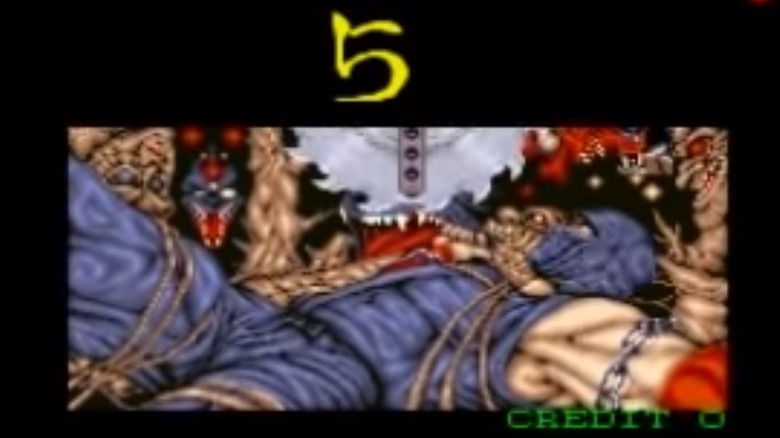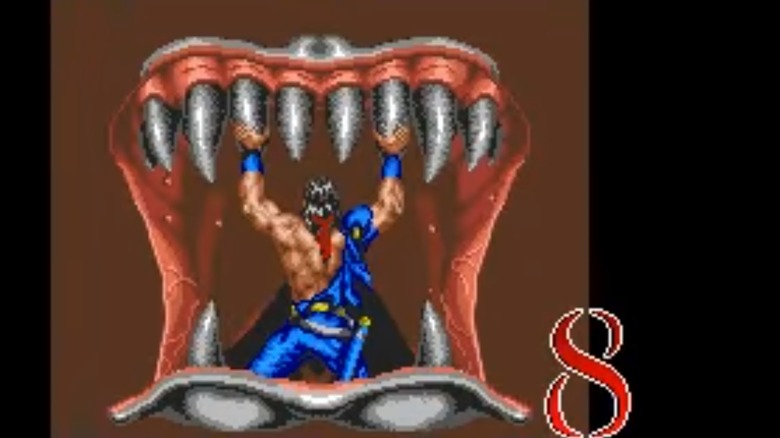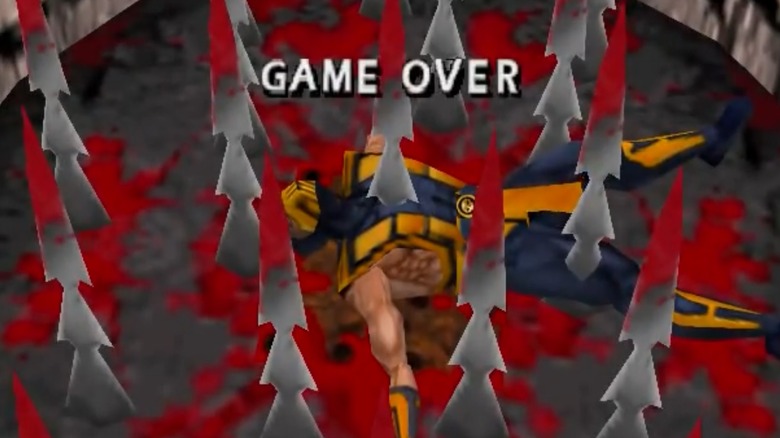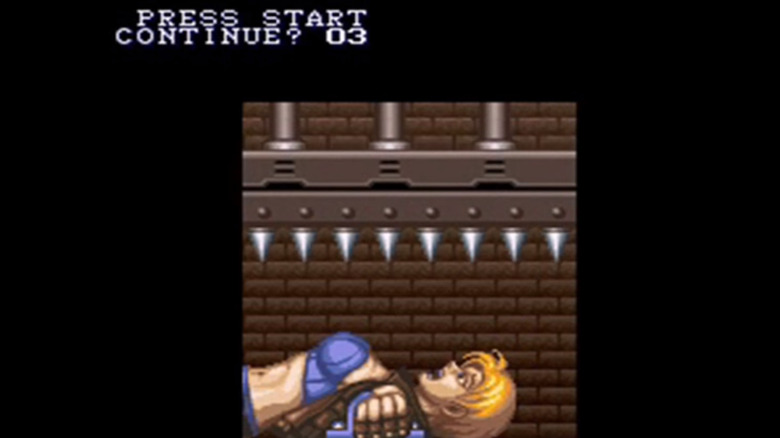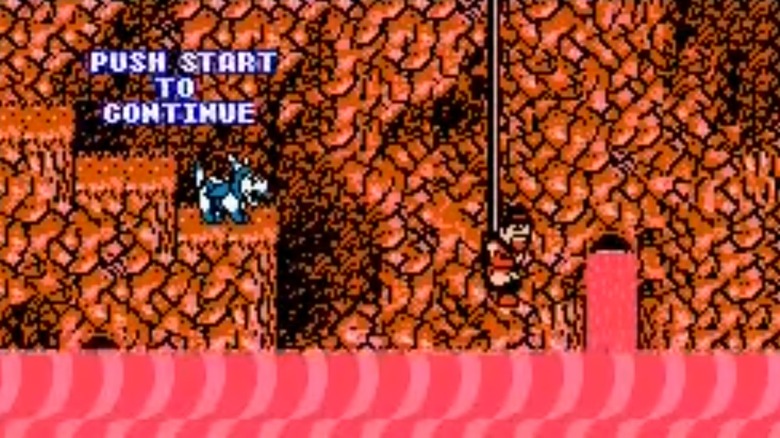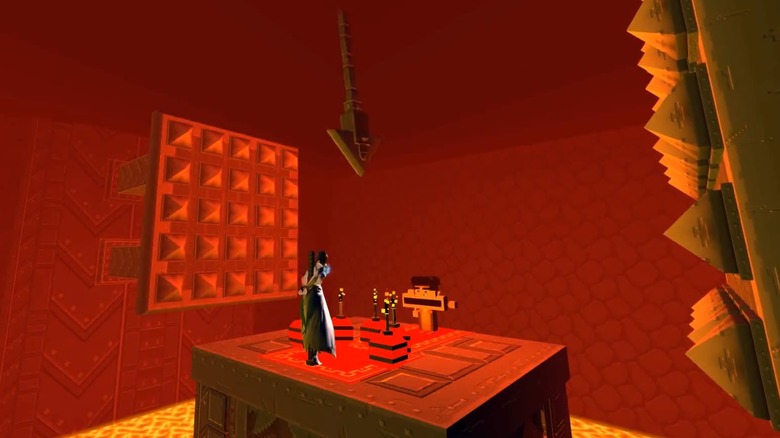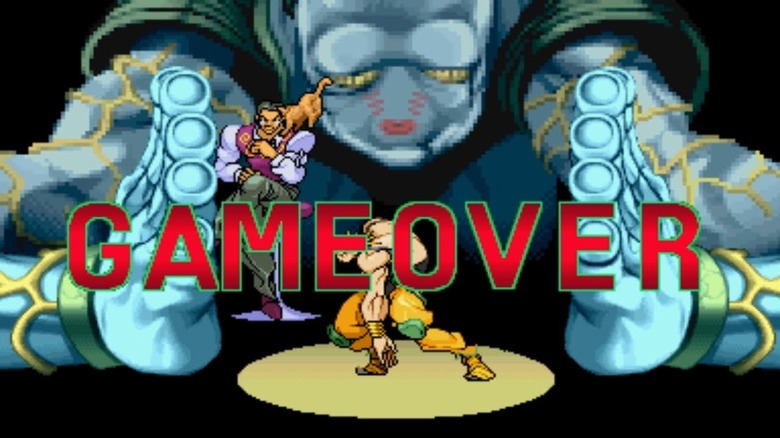Gaming's Most Brutal Continue Screens
The days of video games being confined to arcades have long since passed and, while many still flock to those old cabinets for the sake of nostalgia, most games can be played comfortably at home. The key goal of arcades was always to keep gamers engaged and spending money. One of the best ways to do this was to create continue screens that, instead of giving players a flat game over, allowed them to keep playing if they put more coins into the machines. Of course, these games weren't going to wait around all day while you decided whether or not it was worth another quarter to continue your journey. Thus, the intensely brutal continue screen was born.
While these continue screens are most often found in classic arcade games, there are a handful of newer games that have utilized this strategy to hold players' attention. The most effective continue screens seem to be those that create a sense of panic or urgency in the player, usually by putting their character in some sort of mortal danger that can only be stopped by continuing the game. Whether it's the threat of death or horrible dismemberment, these brutal continue screens have no problem exploiting your emotions to get more time (or coins) out of you.
The Final Fight franchise is fine with traumatizing children
Originally released in 1989, Capcom's Final Fight series is a beat-em-up classic that has proved its staying power in the gaming world. Much like other side-scrolling games in the genre, Final Fight has a pretty basic setup where story and gameplay mechanics are concerned. A group of vigilantes in Metro City fight against the forces of evil, which manifest as criminal gangs and other undesirables. Starting as an arcade game, it's no surprise that the first three installments of Final Fight all feature relatively brutal continue screens designed to guilt gamers into putting more coins into the machine.
Like many continue screens, the player character is put in mortal danger in a variety of scenarios. In the first Final Fight, players find their character tied to a chair with a lit bundle of dynamite in front of them. While the character struggles against their restraints, the fuse gets progressively shorter, threatening to blow your hero up. Whether Capcom's goal was to encourage players to continue the game or to traumatize kids for life, they succeeded on both accounts.
Ninja Gaiden's circular saw is sure to make you continue
Tecmo's 1988 action-adventure hack-and-slash game Ninja Gaiden made a big impact upon its release. It was one of the first games of its kind to use cinematic cutscenes to move the story along, and this only added to the positive reception it received. Playing as the ninja Ryu Hayabusa, gamers travel to America at the bidding of their father to make sure two statues that could potentially end the world don't come into contact with one another. In true hack-and-slash fashion, fights break out and chaos ensues.
If players are unfortunate enough to run out of lives while playing through the unending fights, they're treated to a particularly cruel continue screen. Ryu is found tied to a table as a circular saw slowly lowers towards him, threatening to cut him right in half as he struggles. In a truly bizarre and unexpected twist, Ryu is also surrounded by what appear to be wolves and demonic trees, all of which look just as anxious to kill him as the ever-descending saw. Luckily, you're able to save your hero by simply continuing the game. That seems worth a few coins and extra play time.
Unless you want to see Tecmo Knight eaten, you'll continue
Tecmo Knight, released in 1989 by Tecmo, is a classic Beat-'Em-Up arcade game. The pixelated characters and side-scrolling action are everything you'd expect from a game of this time period. Gamers are able to switch between the titular Tecmo Knight and Smokeman. The knight can also ride his tiger companion, which gives him other special abilities. Fighting against Wild Fang, Tecmo Knight must make his way through hordes of enemies sent after him by his adversary and attempt to get to the climactic showdown.
Failing to make it to the final boss fight against Wild Fang will result in the player character getting one of those classic, panic-inducing continue screens that games loved to use in the '80s and early '90s. This particular continue screen sees the Tecmo Knight trapped between the jaws of a large creature, trying to hold the maw open so that he doesn't get bitten in half or swallowed whole. The knight seems to get weaker and weaker as the countdown clock continues, and if players fail to continue their game, the knight will lose strength and allow the maw to close on him with a scream. To add insult to injury, this game over will also result in Wild Fang appearing to declare that there is "no future," as if you needed a further reminder of your failure.
Mortal Kombat 4 doesn't shy away from blood
The Mortal Kombat franchise is known for its graphic violence and brutal takedowns. It was the first game that really put parents on high alert for violent content in video games. More than likely, many young gamers had to sneak over to a friend's house to play it. While Mortal Kombat felt pretty brutal where blood and gore were concerned, Mortal Kombat 4 was particularly brutal for a different reason.
Losing a game is already harsh enough without having to think about the consequences of your virtual defeat. But Mortal Kombat 4 wasn't going to let gamers off the hook quite so easily. Instead, if you managed to lose the game, you were treated to a tense guilt trip that had you desperately searching your pockets for more coins in order to stay your player character's unfortunate demise.
Whichever character you'd chosen to play as would show up in a seemingly bottomless stone pit, falling continually while the ominous countdown clock let you know how much time you had left to push that continue button. Should you decide not to continue, your character would fall onto a bed of sharp spikes, effectively impaling themselves and, in true Mortal Kombat fashion, bleeding profusely all over the screen. If that's not enough to guilt you into continuing, we don't know what is.
See your spirit -- and body -- get crushed in Final Fight 3
Final Fight had dynamite and fire. Final Fight 2 had water. So what did Final Fight 3 have? Giant spikes, obviously. What else would have been appropriate?
Fail at the third Final Fight side-scroller, and your character will be tied (they're always tied up for some reason) to a wooden plank while a ceiling of spikes slowly descends on them. Your hero will struggle to break free of their bonds, but without the help of you and your pocket change, they are fated for a squishy end. We can only hope that the world produces enough quarters to prevent these terrible street killings by giant spike machines.
Conquest of the Crystal Palace gets animal lovers right in the feels
Quest's 1990 platformer Conquest of the Crystal Palace is pure gaming gold. Playing as Farron, you and your trusty dog Zap must traverse several bizarre and perilous zones on your quest to return to your kingdom, which has been forcefully taken from you and your family. Getting assistance from a shopkeeper and a princess you manage to rescue along your way, you and Zap are able to overcome the forces of evil to set things right. Hopefully.
If you don't manage to conquer all of the forces of evil thrown at you in this game, you're given a heartbreaking continue screen that will get any animal lover to continue playing the game just to satisfy your trusty pup. Farron is seen dangling from a rope over a rising river of what appears to be lava. He is helpless and waiting for you, the player, to press continue to save him.
Meanwhile, Quest used a little animal collateral to make sure you keep playing the game. Off to the side is your dog Zap, barking desperately at you as he attempts to save you. He, of course, can't get to you, leaving the player as the only hope in saving Farron. If that isn't emotional manipulation at its finest in your eyes, you may not have a heart.
MMOs become arcade games in Guild Wars 2
MMOs aren't typically known for their continue screens. Chances are, if you die in an MMO, you don't get a chance to try again. You simply die, respawn, and have to accept your defeat. This is where ArenaNet's MMO Guild Wars 2 changes things up. One of the things that makes Guild Wars 2 different from other MMOs is the living story that the entire community gets to participate in. This story, which generally consists of several quests in private instances between your character and a group of NPCs, comes out in seasons and episodes so that gameplay never becomes stagnant.
One patch that Guild Wars 2 added was the Super Adventure Box. With this box, your fully rendered 3D character entered a pixelated world, reminiscent of classic arcade games. While your character continued to look like a typical MMO avatar, the world around them was anything but standard. Keeping with the tradition of arcade games, if you lost all of your lives while in the Super Adventure Box, you'd receive a continue screen and, not to be outdone by any arcade game, this screen had it all. In this doom room, you'd find your character tied up with a lake of lava slowly rising towards them. This lake had a shark in it, and walls covered in spikes slowly closed in on your character as a swinging ax descended. At least they covered all of their bases.
JoJo's Bizarre Adventure gambled with your soul
This one gives a whole new meaning to the term "clapping out."
In JoJo's Bizarre Adventure, a 1998 multi-platform fighter based on the animated series of the same name, you won't a lot that deviates from other games in the fighting genre. The title was developed by the same team at Capcom that worked on Street Fighter 3, so the two games definitely shared a similar aesthetic and had a lot of gameplay mechanics in common. Where JoJo's Bizarre Adventure blazed its own path, however, was with its continue screens, which were slightly more nasty to the player and definitely encouraged the quick surrender of any remaining quarters.
When you met your temporary end in JoJo's Bizarre Adventure, you were sent to a continue screen to watch your character wobble in front of Daniel J. D'Arby, a gambler who relished in having his Stand, Osiris, steal the souls of those who lost their bets. You, as the character, wagered your life in a battle that you ultimately lost. And those quarters in your pocket? They were a chance to go double-or-nothing in D'Arby's mind; that is, if you were quick enough to funnel them into the coin slot.
If you weren't — or if you were fresh out of quarters to feed into the machine — D'Arby summoned Osiris to collect. And with a single clap of his hands, your character was squashed, leaving nothing behind but a casino token. Ouch.
Tensions -- and waters -- rise in Final Fight 2
In the original Final Fight, your hero was threatened with a fiery blaze; if you lost, the character would be chained up with a pack of dynamite. So for the sequel, Capcom decided to threaten you with water instead. Fail at Final Fight 2, and your character would be tied up in a sealed room while water is poured in from all sides. Sound bad? It is. Worse, you are forced to watch as the waters rise, your hero desperately struggling to keep their mouth away. If that doesn't get you reaching for a quarter, well, nothing will.

